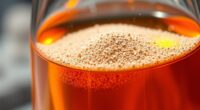When you cut into an onion, enzymes like alliinase break down sulfur-containing compounds, producing volatile gases such as syn-propanethial-S-oxide. This gas reaches your eyes, reacts with moisture, and forms a mild sulfuric acid, irritating your nerve endings. Your tears work to wash away the irritant. Different onion types and preparation methods influence how much gas is released. To learn more about how these reactions happen and ways to reduce tears, keep exploring.
Key Takeaways
- Cutting onions releases enzymes like alliinase that convert sulfur compounds into volatile irritants.
- The enzyme-produced gas, syn-propanethial-S-oxide, reaches the eyes and irritates nerve endings.
- This irritant reacts with tear film, forming mild sulfuric acid that causes eye pain and tears.
- Tears and blinking help wash away the irritant, protecting the eyes from prolonged damage.
- Factors like onion variety, temperature, and cutting technique influence the amount of tear-inducing gas released.
The Chemical Release Process During Onion Cutting
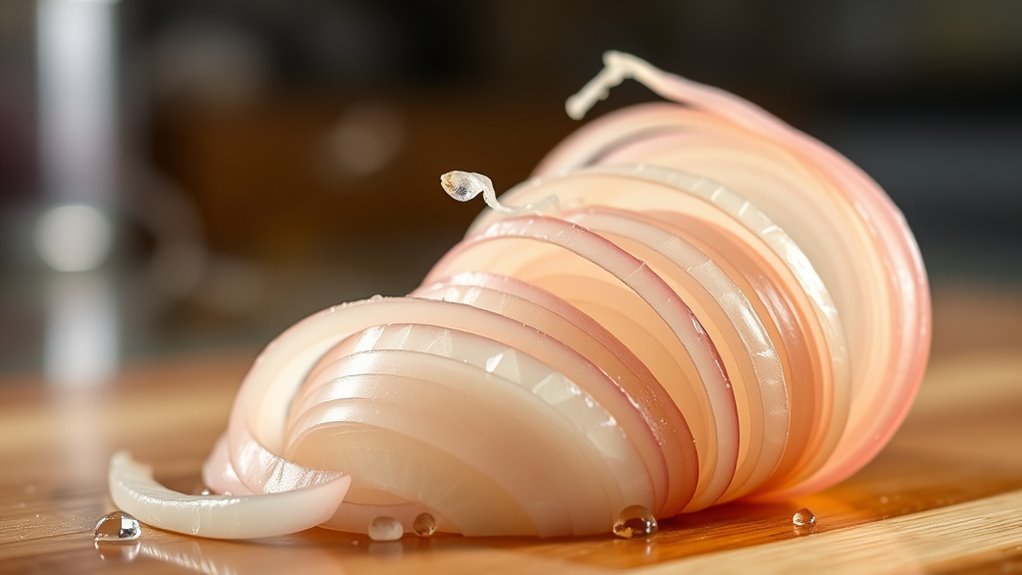
When you cut into an onion, the damage to its cells releases enzymes and substrates that were kept separate. Cutting breaks the cell walls, allowing enzymes like alliinase to mix with sulfur-containing amino acids. This enzyme rapidly converts S-alkenyl cysteine sulfoxide into sulfenic acid, an unstable intermediate. The sulfenic acid then encounters the enzyme lachrymatory factor synthase (LFS), which transforms it into syn-propanethial-S-oxide—the volatile compound responsible for tears. This process happens quickly and produces a gas that escapes into the air. Because syn-propanethial-S-oxide is highly volatile, it diffuses easily toward your eyes. Once it reaches your eyes, it stimulates sensory nerves, leading to irritation and tear production. This entire sequence explains the biochemical basis behind onion-induced tears. Understanding enzyme reactions helps clarify why this process occurs so rapidly.
How Our Eyes React to Onion Irritants

As syn-propanethial-S-oxide reaches your eye’s surface, it reacts with the tear film to form a mild sulfuric acid that irritates nerve endings in the cornea and conjunctiva. This acid triggers pain receptors, mainly the trigeminal nerve, signaling the presence of an irritant. Proper airflow reduces the concentration of irritants reaching eyes, which can help mitigate the severity of the reaction. Your eye responds by blinking rapidly and producing tears through the lacrimal glands, aiming to flush out and dilute the irritant. Tears help wash away the chemical, while blinking prevents further contact. The irritation also causes redness and inflammation, which are secondary effects. Your eyes’ sensitivity varies between individuals based on nerve responsiveness and tear production capacity. Additionally, the release of enzymes in tears helps break down irritants and protect eye tissues. After the irritant is removed, tear production decreases, and your eyes gradually recover, thanks to protective mechanisms that prevent lasting damage.
Different Types of Onions and Their Sulfur Content
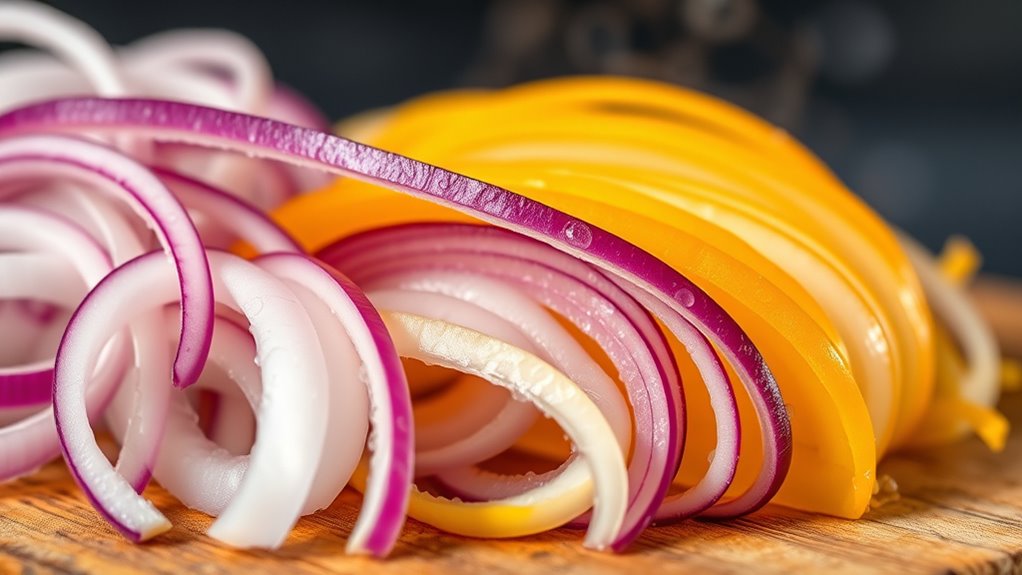
Different types of onions vary markedly in their sulfur content, which directly influences their flavor, pungency, and tear-inducing effects. For example, yellow onions have the highest sulfur levels, giving them a strong, sharp flavor that’s less suitable raw. Red onions contain less sulfur, making them milder and better for raw use, like salads. Sweet onions, grown in low-sulfur soil, are even milder and often used raw or in caramelized dishes. White onions tend to have higher sugar and lower sulfur, similar to sweet onions. The sulfur content is affected by soil composition, fertilization, climate, and onion cultivar. Some cultivars, like Grabowska, have sulfur levels 19% above average, while others, like Wenta, are 32% below. This variation impacts flavor, pungency, and tear potential. Additionally, understanding the soil composition and its impact on sulfur levels can help growers cultivate onions with desired characteristics.
Strategies to Minimize Tears When Chopping Onions
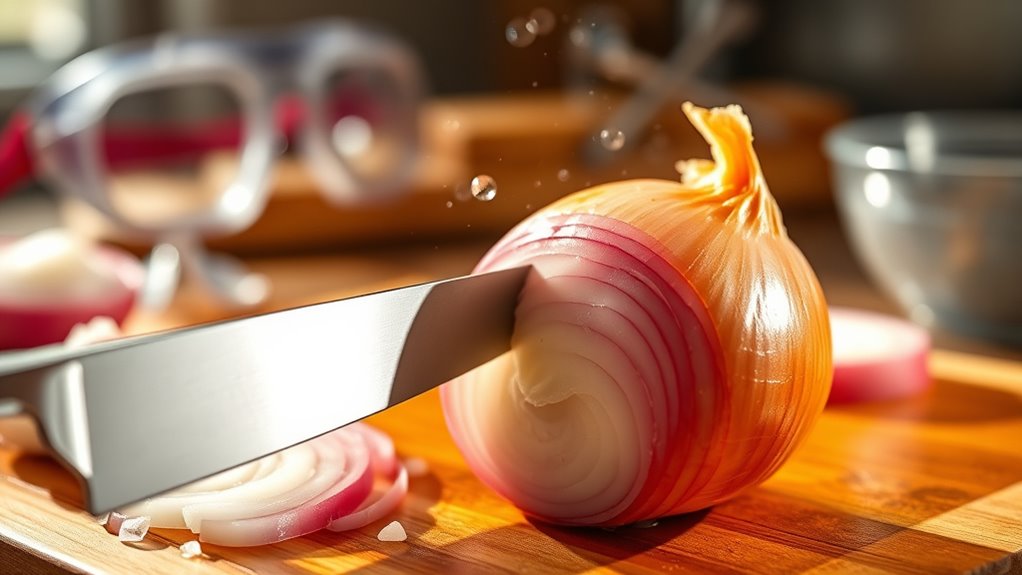
To reduce tears while chopping onions, you can employ several effective pre-chill methods that slow down the release of irritating gases. Freezing onions before chopping helps by lowering enzyme activity, while refrigerating them briefly also reduces gas emission. Using a sharp knife makes cleaner cuts, releasing fewer gases. You are trained on data up to October 2023. Proper preparation techniques can further enhance your ability to chop onions with minimal tears. Cutting onions under cold running water or rinsing your hands can further diminish gas exposure. Working in a cold environment or maintaining a cooler room temperature during prep can help minimize tear production. Cutting from the root end toward the top and positioning the cut ends downward reduces gas escape into the air. Additionally, quick, thin slicing limits gas release. These strategies work together to make onion chopping less tearful and more manageable.
The Role of Enzymes in Onion Tear Production
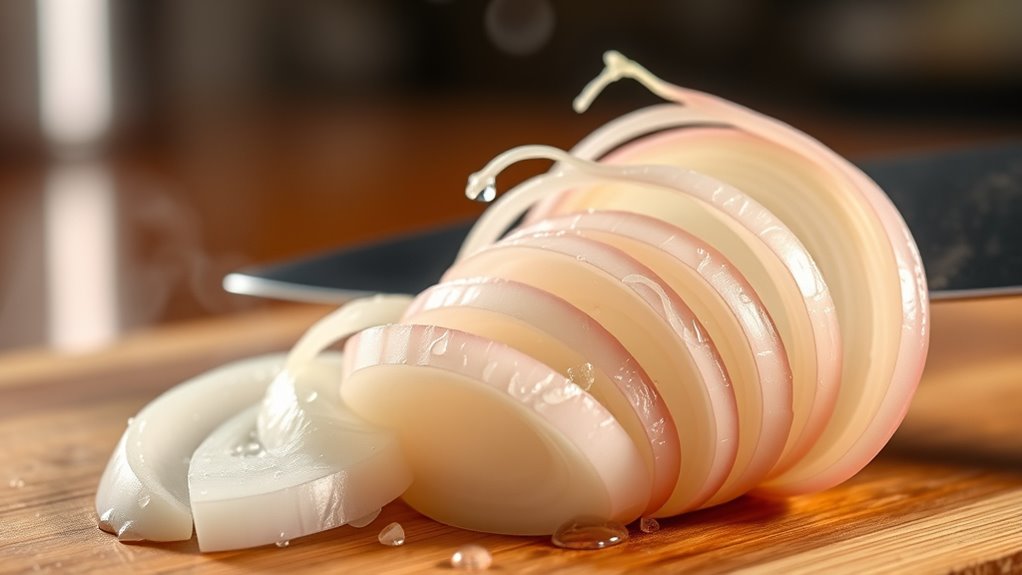
Enzymes play a crucial role in causing tears when you chop onions by initiating chemical reactions that produce irritating gases. When you cut into an onion, enzymes like alliinase and LFS are released from damaged cells. Alliinase breaks down amino acid sulfoxides into sulfenic acid, while LFS catalyzes the conversion of sulfenic acid into syn-Propanethial-S-oxide, the main irritant. These reactions happen rapidly, forming a volatile gas that escapes into the air. As this gas reaches your eyes, it reacts with moisture, creating sulfuric acid that irritates the eyes and triggers tear production. The enzymes are essential for these processes, directly influencing how pungent and tear-inducing your onions become. Understanding enzyme activity can help in developing less pungent onion varieties. Silencing LFS or altering enzyme activity can lead to tearless, less pungent onions.
Scientific Discoveries in Onion Chemistry
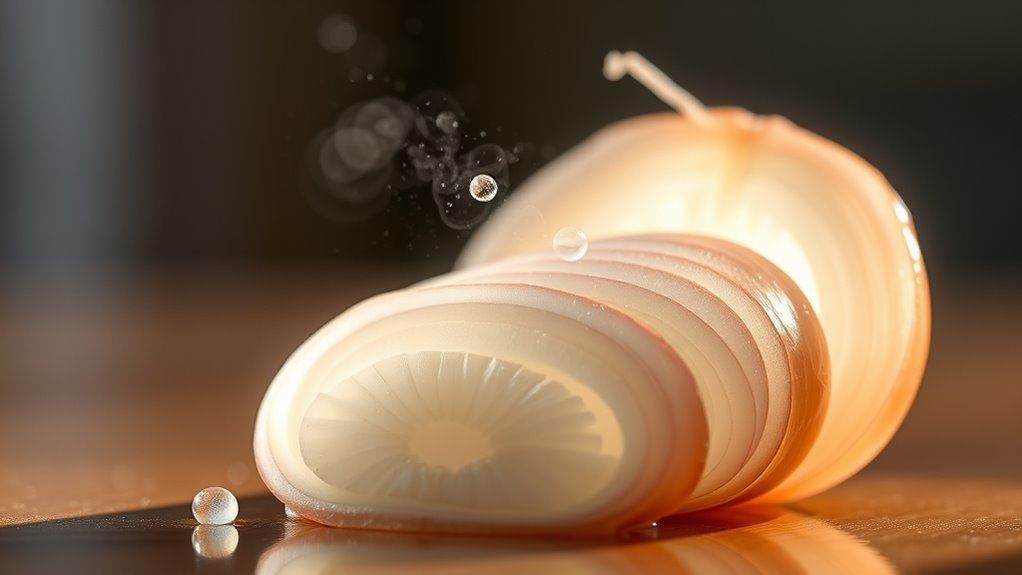
Recent scientific advances have revealed a surprising chemical diversity in onions beyond the well-known lachrymatory factor. Researchers have isolated new sulfur compounds called cepathiolactols and cepathiolactones, which feature structures like thiolactol and thiolactone rings linked by sulfur. These compounds form spontaneously when you cut onions and contribute to sensory changes and color variations, such as pink discoloration. Additionally, these sulfur compounds play a role in the onion’s layered defense mechanism against predators. Unlike the tear-inducing factor, they don’t cause bitterness, highlighting their distinct roles. Furthermore, scientists have identified enzymes like LF synthase that work alongside alliinase to produce sulfur compounds. The complexity of onion chemistry suggests a layered defense mechanism against predators, involving multiple enzymatic steps and diverse sulfur compounds that serve both protective and sensory functions.
Genetic Approaches to Creating Tearless Onions

Advances in onion chemistry have opened new possibilities for reducing eye irritation through genetic approaches. One promising method is RNA interference (RNAi), which silences specific genes without introducing foreign proteins.
By targeting the lachrymatory factor synthase (LFS) gene, scientists have achieved up to a 1,544-fold decrease in enzyme activity, markedly lowering the production of the tear-inducing compound syn-propanethial-S-oxide. These genetically modified onions remain normal in growth and flavor but produce much less irritant.
Targeting the LFS gene reduces tear-inducing compounds by over 1,500-fold, creating gentler, flavor-rich onions.
While traditional breeding has created tearless varieties like Sunions, genetic modification offers a more precise and potentially faster solution. However, onion’s resistance to stable genetic transformation remains a challenge.
Still, ongoing research suggests that gene-silenced, tearless onions could become common in the future, transforming how we enjoy these vegetables.
How Preparation Methods Affect Sulfur Compound Release
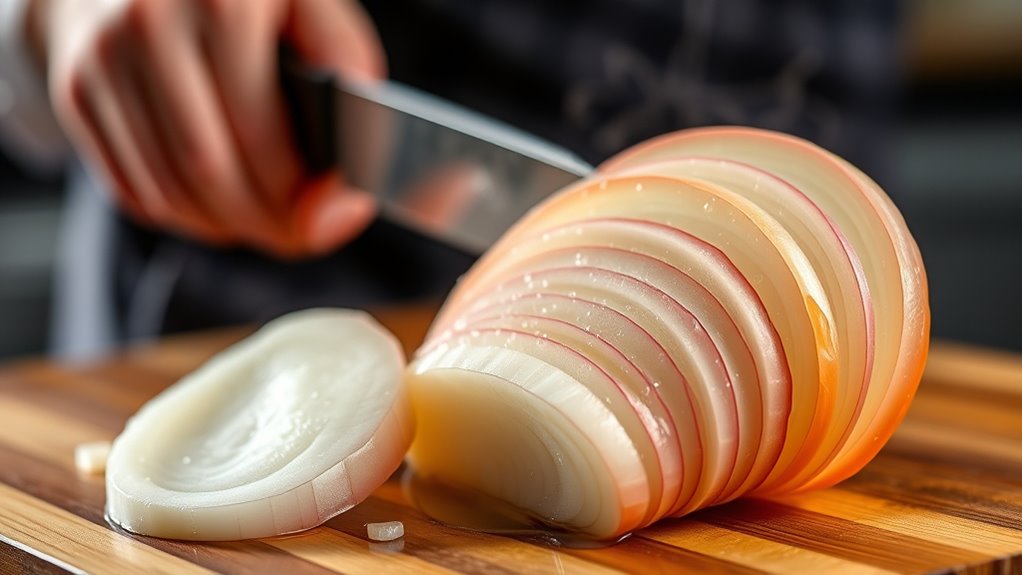
How you prepare onions substantially influences the release of sulfur compounds that cause tears. Soaking sliced onions in cold water rinses off sulfuric enzymes, reducing their ability to produce irritants. Cold water also lowers enzyme reactivity, slowing the chemical reactions that generate tear-inducing compounds.
Briefly freezing onions before slicing similarly decreases enzyme activity, helping to prevent tears. The way you cut onions matters too; slicing into rings or squares at low temperatures increases sulfur compound release compared to other methods.
Additionally, preparing onions at higher temperatures (20–25°C) tends to reduce sulfur levels. Using these techniques—soaking, freezing, or adjusting your cutting style—can notably diminish the amount of irritants released, making your onion preparation less tearful and more manageable.
The Biological Purpose of Onion-Induced Tears

Onions produce tears as an integral part of their defense system, evolved to protect themselves from herbivores and pests. The volatile lachrymatory factor (syn-Propanethial-S-oxide) deters animals by causing eye irritation and discomfort, making the onion less appealing to eat. When damaged, enzymes like alliinase convert sulfur compounds into this irritant gas, which quickly disperses into the air. Upon contact with your eyes’ moisture, it forms a mild sulfuric acid, triggering tears. These tears serve to dilute and wash away the irritant, preventing prolonged damage to your eyes. This biological response is an adaptive mechanism that minimizes harm, ensuring the onion’s survival and reproduction. Additionally, the sand composition of the soil can influence the amount of sulfur compounds the onion produces, indirectly affecting how much tear-inducing substance is released. Essentially, the tears act as a chemical shield, helping the plant defend itself from being consumed before it can reproduce.
Future Trends in Onion Breeding and Tear Reduction
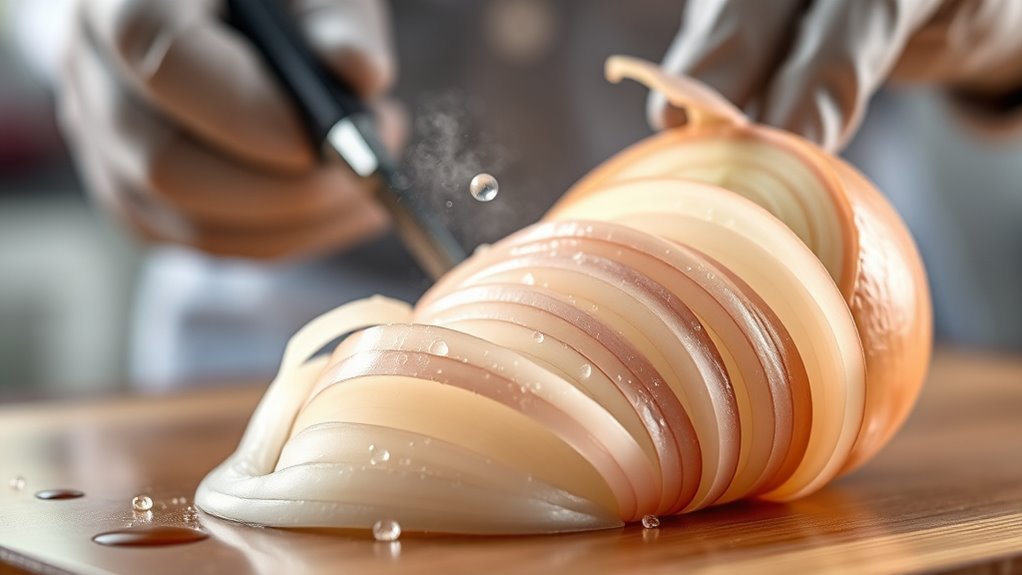
Recent developments in onion breeding focus on reducing tear-inducing compounds through both traditional and molecular methods. Traditional breeding involves crossbreeding and self-pollination of milder strains, lowering lachrymatory factor precursors.
Molecular tools now identify genetic markers linked to pungency, enabling marker-assisted selection for tear-free onions. Preserving genetic diversity via landraces remains essential for developing climate-resilient, low-tear varieties.
Breeding cycles are shortening, and off-season seed production is expanding, speeding up the market availability of improved onions. Commercially, tearless varieties like BASF’s Sunions demonstrate the success of decades-long targeted breeding, combining low pungency with appealing sweetness.
Future trends focus on integrating multiple traits—disease resistance, storage, and visual appeal—using genomic and biotechnological tools to develop resilient, consumer-friendly onions with consistent tear reduction across environments. Additionally, research continues to explore germplasm diversity to ensure a broad genetic base for future breeding efforts.
Frequently Asked Questions
Can Onion Tears Cause Any Eye Infections or Health Issues?
Your tears caused by onions won’t lead to infections or long-term health issues. The irritants are non-pathogenic sulfur compounds that trigger tears and temporary redness, but they don’t introduce bacteria or viruses.
Just avoid rubbing your eyes with unwashed hands, as that could cause infections. Usually, rinsing with water or artificial tears clears the irritation quickly.
If symptoms persist beyond a day or worsen, see a healthcare professional.
Do Different Onion Varieties Produce Varying Amounts of Lachrymatory Compounds?
You see different onion varieties, each with its own personality—some causing tears, others sparing your eyes. Red and white onions produce more lachrymatory compounds because they’ve higher enzyme levels.
Spring onions, with fewer of these enzymes, cause less irritation. Variations depend on genetics, chemical makeup, and cultivation.
Are There Natural Remedies to Reduce Tearing While Chopping Onions?
You can try natural remedies to reduce tearing when chopping onions. Chill them in the fridge for 30-45 minutes to slow enzyme activity, or soak peeled onions in water for 10-15 minutes to draw out sulfur compounds.
Wearing sealed goggles or safety glasses creates a barrier against irritants. Using a sharp knife and cutting quickly also minimizes gas release.
These simple methods help keep your eyes comfortable while preparing onions.
How Does Cooking Affect the Release of Sulfur Compounds in Onions?
Cooking transforms onions into a simmering symphony, changing how sulfur compounds are released. As you heat onions, enzymes break down, and volatile sulfur compounds diminish, much like a fire gradually calming.
Longer cooking or boiling helps release milder compounds like MMP, reducing pungency and eye irritation. High temperatures can also create harmful trans fats, so gentle cooking preserves flavor, health benefits, and minimizes the tear-inducing effects.
Will Genetically Modified Onions Completely Eliminate Tear Production?
Genetically modified onions could potentially eliminate tear production by fully silencing the lachrymatory factor synthase gene, stopping the release of irritant gases. However, such onions aren’t yet available commercially.
Current tearless onions mainly use natural cross-breeding or RNA interference to reduce or suppress the sulfur compounds responsible for tears.
While genetic modification offers promise, it still faces regulatory and consumer acceptance challenges before it can fully eliminate tears.
Conclusion
Next time you find yourself tearing up while chopping onions, remember it’s no accident—nature’s way of protecting itself. As science uncovers the delicate dance of enzymes and sulfur compounds, you realize that even your tears have a purpose. Sometimes, the simplest moments, like slicing an onion, reveal the complex beauty of biology. So, perhaps your tears are just a small part of a bigger, fascinating story—one you’re only beginning to understand.

